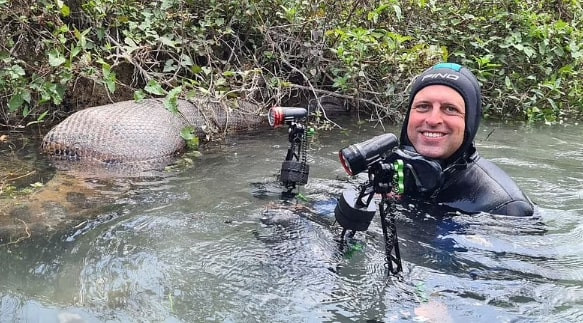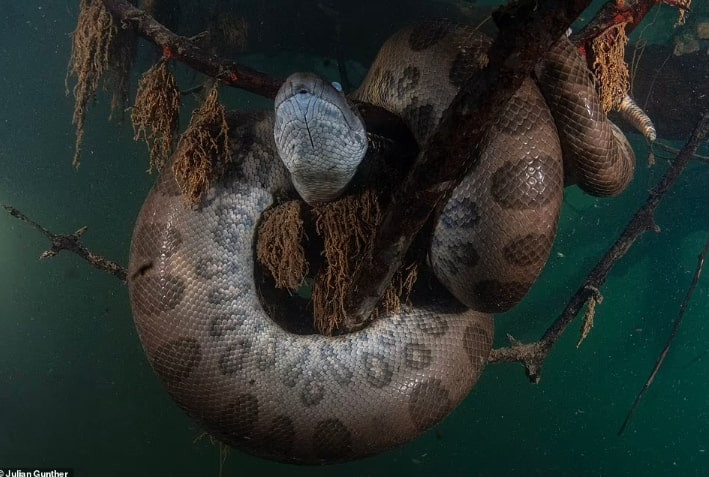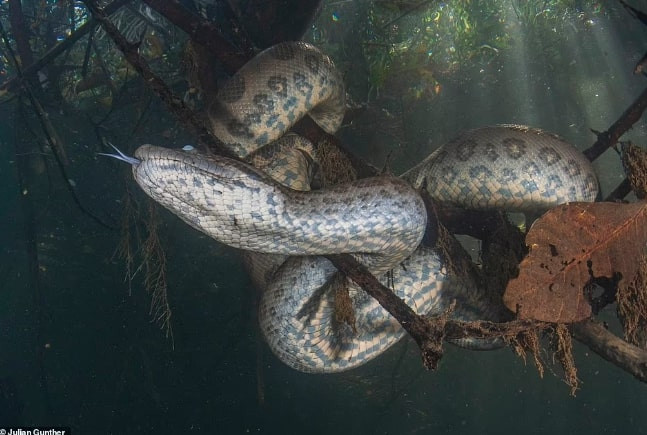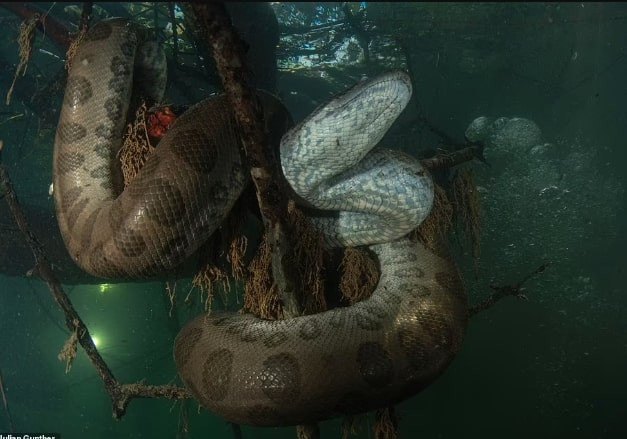“I was very worried at first. The python turned towards me, licked the camera for about 20 or 30 seconds and then retreated.”
Explorer Julian Gunther’s incredible photographs reveal the life of anacondas, one of the world’s largest pythons, in the wetlands of South America. He spent hours submerged underwater to get close to the giant creatures.

Julian Gunther dived for hours underwater to photograph giant pythons. Photo: Daily Mail
Pythons can sometimes grow up to 7 metres long, coiling around tree branches and hiding under water. They move around, sometimes revealing forked tongues and glassy eyes submerged in dark water.
The 44-year-old explorer said taking realistic photos of this giant, elusive creature requires a lot of preparation and careful planning. One of the important things is to understand the warning signs of when not to touch them. Always give pythons an outlet, never “corner” them.

The python curled up in the water. Photo: Correo diario
According to Julian, the idea that the anaconda is very aggressive and attacks everything that gets in its way is wrong. The 1997 horror film Anaconda, starring Jennifer Lopez and Ice Cube, contributed to people’s unfounded fear of the animal.
He said: “To properly and safely interact with these large creatures, a lot of basic research needs to be done on behaviour, warning signs of danger… However, we humans do not have giant pythons on the menu. The only reason pythons attack people is because they feel disturbed, cornered and with no way out.”

Julian approached the python at close range to take the clearest photo. Photo: Daily Mail
He and the explorers travelled by boat along the tributaries of the mangrove area. Pythons usually spend a lot of time underwater, sometimes hiding under tree branches.
After discovering the python’s location, he attempted to enter the water slowly and cautiously. He was careful when moving so as not to alarm the animal or scare it.
Sometimes pythons actively approach the camera at close range. At this time, you should try to stay calm and not move suddenly. “Most of the time, pythons just come to check the camera and then retreat,” he said.
However, he admitted that his first encounter with a large adult python was scary. Pythons are up to 7 metres long, fat and have eyes that stare straight into the camera.
“I was very worried at first. The python turned towards me, licked the camera for about 20-30 seconds, and then backed away. I was scared, but I tried to remember what I had learned and my experience in dealing with this snake. Other animals tried to stay calm. Their actions let me know that it was very comfortable and I could back up a little further to take more photos,” he shared.
What surprised him most when encountering giant pythons up close was their gentle nature. The large pythons he encountered came close to check out the camera, watched, and then walked away without attacking or causing any danger.

South America’s wetlands are home to many giant pythons. Photo: Correo diario
The first time Julian came into contact with pythons was when he was a child, during a day at the Rio de Janeiro zoo. He was completely overwhelmed when he saw the giant reptiles. “They are enormous in the eyes of a 4-year-old child,” he said.
As he grew older, his curiosity about giant creatures grew. He read Brazilian myths and folklore related to giant pythons and some other animals. He always wanted to see them up close.
Photographing reptiles and sea creatures in their natural habitats gradually became Julian’s lifelong passion. He often goes on expeditions with his wife and both want to pass on their love of wildlife to their daughter.




